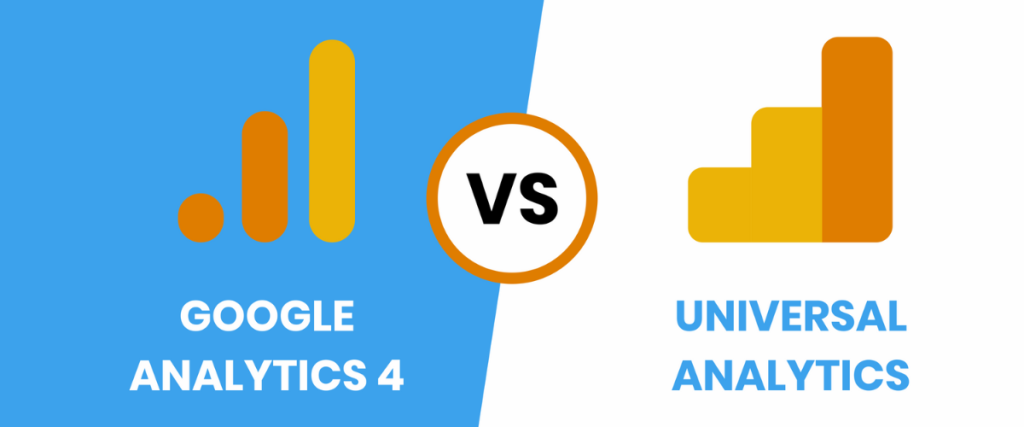By now, it is likely that you have taken steps to migrate to GA4, whether that be by your own accord or Google auto-creating a GA4 property on your behalf as we approach the transition deadline. The next step is to get a thorough understanding of the new GA4 ways of tracking, saying bye bye to Universal Analytics for good!
Google Analytics has long been a trusted tool for marketers and website owners for analysing user behaviour and making data driven decisions. GA4 brings significant changes compared to its predecessor, Google Universal Analytics, revolutionising how we track and measure user interactions. In this blog post, we’ll explore the five main differences between Google Universal Analytics and GA4 to get your started, highlighting the advantages and implications of each difference. By understanding these distinctions, we can adapt our data analysis strategies and make the most out of the powerful features GA4 has to offer.
1. Data Model: Session-Based vs. Event-Based
Google Universal Analytics relies on a session-based data model, grouping user interactions into sessions. A session starts when a user visits a website and ends after a period of inactivity or when the session times out. This approach provides aggregated data on user behaviour during a session but may not capture detailed insights into individual actions.
In contrast, GA4 introduces an event-based data model, focusing on individual user actions or events. Each user interaction, such as page views, clicks, and conversions, is treated as a separate ‘event’. This event-based model provides a more granular understanding of user behaviour, enabling businesses to track and analyse specific actions taken by users.
The event-based model of GA4 allows for greater flexibility in tracking user behaviour across multiple platforms, including websites, mobile apps, and other digital touch points (these are data streams within GA4). It offers a comprehensive view of how users interact with different channels, devices, and platforms, empowering marketers to gain deeper insights into user journeys and optimise their marketing strategies accordingly.
2. Tracking and Measurement: Enhanced Measurement Setup
Another notable difference between Google Universal Analytics and GA4 lies in the tracking and measurement capabilities. Universal Analytics typically requires manual tagging and configuration to track various dimensions and metrics accurately. This process can be time-consuming and prone to human error.
In contrast, GA4 introduces an enhanced measurement setup, which simplifies the tracking process and improves accuracy. With GA4, certain standard events (clicks, scrolls, newsletters sign ups etc.) and parameters are automatically collected, eliminating the need for extensive manual tagging. This automated approach streamlines the implementation process and ensures that businesses have more accurate and comprehensive data by default. GA4’s enhanced measurement setup also enables cross-platform tracking, allowing businesses to gain insights into user behaviour across websites, mobile apps, and other digital platforms.
3. User-Centric Reporting: Understanding the Complete User Lifecycle
One of the significant shifts in GA4 is its user-centric reporting approach. Unlike Universal Analytics, which primarily focuses on sessions, GA4 emphasizes analysing user behaviour and engagement throughout their entire lifecycle.
By shifting the focus to individual users, GA4 provides a more accurate representation of user engagement, allowing businesses to make data-driven decisions that align with their target audience’s needs. This user-centric approach is particularly valuable for businesses aiming to enhance customer retention, improve customer experiences, and drive long-term growth.
4. Artificial Intelligence (AI) and Machine Learning (ML): Unlocking Powerful Insights
AI is a hot topic in the digital marketing world in 2023 and one of the most exciting advancements in GA4 is its integration of artificial intelligence (AI) and machine learning (ML) capabilities. GA4 leverages AI and ML algorithms to provide automated insights, predictive analytics, and advanced reporting features.
Predictive metrics: GA4 employs machine learning algorithms to generate predictive metrics, which help businesses anticipate user behaviour and make proactive decisions. These metrics can provide valuable insights into future trends, enabling marketers to optimise their strategies and stay ahead of the competition.
Anomaly detection: GA4’s AI-powered anomaly detection feature automatically identifies unusual spikes or drops in user behaviour, highlighting potential areas of concern or opportunities. This capability allows businesses to quickly react to significant changes and investigate the underlying factors behind the anomalies.
Audience forecasting: With GA4, marketers can utilise audience forecasting to predict future audience sizes and behaviours based on historical data. This information helps businesses make informed decisions about resource allocation, budgeting, and campaign planning.
By leveraging AI and ML capabilities, GA4 empowers businesses to uncover valuable insights, automate routine tasks, and allocate resources more effectively. These advanced features enable marketers to focus on strategic initiatives and derive actionable insights from their data.
5. Event-Driven Configuration and Setup: Simplifying Implementation
Implementing tracking codes and configuring analytics setups can be complex and time-consuming in Universal Analytics. However, GA4 simplifies this process through its event-driven configuration and setup.
GA4 uses enhanced measurement events, which automatically capture certain standard events and parameters without the need for extensive manual tagging. This streamlined approach reduces the risk of missing important data points and ensures that businesses have a solid foundation for analysis and reporting from the start.
Google Analytics 4 represents a significant shift in how we track, analyse, and utilise user data for informed decision-making but by understanding the key differences and embracing the transition, businesses are sure to reap long-term benefits from its enhanced capabilities.
